

This article demonstrates the potential of applying GIS viewshed analysis to Roman urban studies. It examines the visual dynamics of the Roman city of Empúries, Spain, through an analysis of the visibility of, and view from, a temple and a domus within the city. The analysis proves that the two buildings in question would have had wide views of the Gulf of Roses to the east of the city, and could easily have been seen by people in boats in the Gulf, but they were virtually invisible from within the city and would certainly not have dominated the cityscape. The article concludes that the absence of the villa and temple from the intramural cityscape of Empúries cautions modern investigators of ancient cities against simply assuming that currently prominent ruins on hills or ridges were also highly visible from near as well as far in antiquity.
Go to article table of contents
Alan E. Kaiser
Assistant Professor of Archaeology
Department of Archaeology/Art History
University of Evansville
1800 Lincoln Avenue
Evansville, IN 47722 USA
Email: ak58@evansville.edu
© Internet Archaeology
URL: http://intarch.ac.uk/journal/issue14/4/toc.html
Last updated: Thu Mar 20 2003